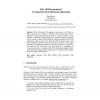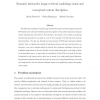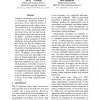729 search results - page 84 / 146 » Learning how to learn with web contents |
115
Voted
WSDM
2010
ACM
15 years 10 months ago
2010
ACM
We describe an approach for multi-modal characterization of social media by combining text features (e.g. tags as a prominent example of short, unstructured text labels) with spat...
103
Voted
ESWS
2008
Springer
15 years 2 months ago
2008
Springer
When a Semantic Web application encounters a new URI in an RDF statement, how should it determine what resource that URI is intended to denote, and learn more about it? Since asser...
122
click to vote
MMS
2008
15 years 15 days ago
2008
We address the challenge of semantic gap reduction for image retrieval through an improved SVM-based active relevance feedback framework, together with a hybrid visual and concept...
94
Voted
WWW
2008
ACM
16 years 1 months ago
2008
ACM
Social media such as Web forum often have dense interactions between user and content where network models are often appropriate for analysis. Joint non-negative matrix factorizat...
95
Voted
ACL
2009
14 years 10 months ago
2009
Sentiment classification refers to the task of automatically identifying whether a given piece of text expresses positive or negative opinion towards a subject at hand. The prolif...



